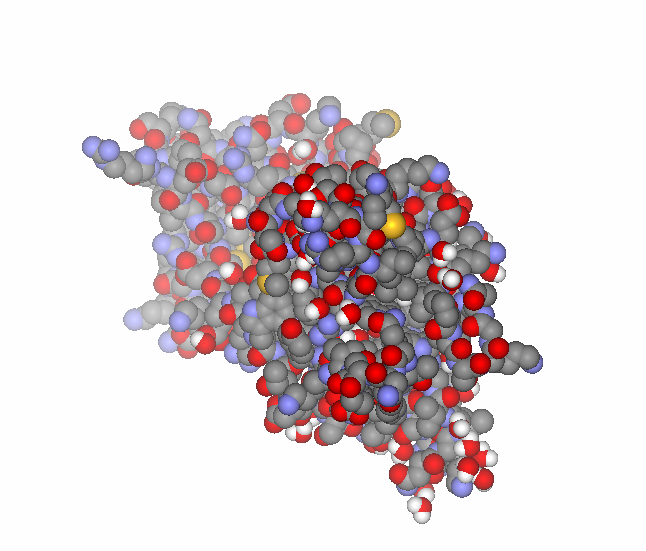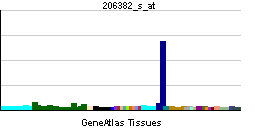Brain-derived neurotrophic factor: Difference between revisions
No edit summary |
m (Bot: Automated text replacement (-{{SIB}} + & -{{EH}} + & -{{EJ}} + & -{{Editor Help}} + & -{{Editor Join}} +)) |
||
| Line 51: | Line 51: | ||
'''Assistant Editor-in-Chief:''' Nelofar Adnan, M.D. [mailto:nelofar.adnan@gmail.com] | '''Assistant Editor-in-Chief:''' Nelofar Adnan, M.D. [mailto:nelofar.adnan@gmail.com] | ||
==Overview== | ==Overview== | ||
| Line 112: | Line 112: | ||
{{Hormones}} | {{Hormones}} | ||
{{Nerve growth factor family}} | {{Nerve growth factor family}} | ||
[[Category:Neurotrophins]] | [[Category:Neurotrophins]] | ||
[[Category:Peptide hormones]] | [[Category:Peptide hormones]] | ||
Revision as of 23:07, 8 August 2012
| Brain-derived neurotrophic factor | |||
|---|---|---|---|
 PDB rendering based on 1bnd. | |||
| Identifiers | |||
| Symbols | BDNF ; MGC34632 | ||
| External IDs | Template:OMIM5 Template:MGI HomoloGene: 7245 | ||
| RNA expression pattern | |||
 | |||
| More reference expression data | |||
| Orthologs | |||
| Template:GNF Ortholog box | |||
| Species | Human | Mouse | |
| Entrez | n/a | n/a | |
| Ensembl | n/a | n/a | |
| UniProt | n/a | n/a | |
| RefSeq (mRNA) | n/a | n/a | |
| RefSeq (protein) | n/a | n/a | |
| Location (UCSC) | n/a | n/a | |
| PubMed search | n/a | n/a | |
Editor-In-Chief: C. Michael Gibson, M.S., M.D. [2] Phone:617-632-7753
Assistant Editor-in-Chief: Nelofar Adnan, M.D. [3]
Overview
Brain-derived neurotrophic factor (BDNF) is a neurotrophic factor found in the brain and the periphery. It is a protein that acts on certain neurons of the central nervous system and the peripheral nervous system that helps to support the survival of existing neurons and encourage the growth and differentiation of new neurons and synapses. In the brain, it is active in the hippocampus, cortex, and basal forebrain—areas vital to learning, memory, and higher thinking. BDNF was the second neurotrophic factor to be characterized, after nerve growth factor (NGF) and neurotrophin three (NT-3).
Although the vast majority of neurons in the mammalian brain are formed prenatally, parts of the adult brain retain the ability to grow new neurons from neural stem cells in a process known as neurogenesis. Neurotrophins are chemicals that help to stimulate and control neurogenesis, BDNF being one of the most active. Mice born without the ability to make BDNF suffer developmental defects in the brain and sensory nervous system, and usually die soon after birth, suggesting that BDNF plays an important role in normal neural development.
Despite its name, BDNF is actually found in a range of tissue and cell types, not just in the brain. It is also expressed in the retina, the CNS, motor neurons, the kidneys, and the prostate.
Effects of stress and BDNF's link in depression
Exposure to stress and the stress hormone corticosterone has been shown to decrease the expression of BDNF in rats, and leads to an eventual atrophy of the hippocampus if exposure is persistent. Similar atrophy has been shown to take place in humans suffering from chronic depression. The ventral prelimbic cortex and the nucleus accumbens have been implicated in the pathophysiology of depressive behavior. In addition, rats bred to be heterozygous for BDNF, therefore reducing its expression, have been observed to exhibit similar hippocampal atrophy, suggesting that an etiological link between the development of depressive illness and regulation of BDNF exists. On the other hand, the excitatory neurotransmitter glutamate, voluntary exercise, caloric restriction, intellectual stimulation, and various treatments for depression (such as antidepressants and electroconvulsive therapy) strongly increase expression of BDNF in the brain, and have been shown to protect against this atrophy. It has been shown that subconvulsive electrical stimulation (SCES)can induce an antidepressant effect similar to that of electroconvulsive therapy,by reducing BDNF levels in the hippocampus that were induced by chronic mild stress.[1]
Mechanism of action for BDNF
BDNF binds at least two receptors on the surface of cells which are capable of responding to this growth factor, TrkB (pronounced "Track B") and the LNGFR (for "low affinity nerve growth factor receptor", also known as p75).
TrkB is a receptor tyrosine kinase (meaning it mediates its actions by causing the addition of phosphate molecules on certain tyrosines in the cell, activating cellular signaling). There are other related Trk receptors, TrkA and TrkC. Also, there are other neurotrophic factors structurally related to BDNF: NGF (for Nerve Growth Factor), NT-3 (for Neurotrophin-3) and NT-4 (for Neurotrophin-4). While TrkB mediates the effects of BDNF and NT-4,TrkA binds and is activated by NGF, and TrkC binds and is activated by NT-3. NT-3 binds to TrkA and TrkB as well, but with less affinity.
The other BDNF receptor, the LNGFR, plays a somewhat less clear role. Some researchers have shown the LNGFR binds and serves as a "sink" for neurotrophins. Cells which express both the LNGFR and the Trk receptors might therefore have a greater activity - since they have a higher "microconcentration" of the neurotrophin. It has also been shown, however, that the LNGFR may signal a cell to die via apoptosis - so therefore cells expressing the LNGFR in the absence of Trk receptors may die rather than live in the presence of a neurotrophin.
Other diseases associated with low BDNF levels
Various studies have shown possible links between low levels of BDNF and conditions such as depression, schizophrenia, Obsessive-compulsive disorder, Alzheimer's disease, Huntington's disease, Rett syndrome, and dementia, though it is still not known whether these levels represent a cause or a symptom.
High BDNF levels
High levels of BDNF and Substance P have been found associated with increased itching in eczema[2].
Epilepsy
Epilepsy has also been linked with polymorphisms in BDNF. Given BDNF's vital role in the development of the landscape of the brain, there is quite a lot of room for influence on the development of neuropathologies from BDNF.
Levels of both BDNF mRNA and BDNF protein are known to be up-regulated in epilepsy (Gall C, et.al. 1991). BDNF modulates excitatory and inhibitory synaptic transmission by inhibiting GABAA-receptor mediated post-synaptic currents. This provides a potential reason for the observed up-regulation.
References
- ↑ Gersner R, Toth E, Isserles M, Zangen A (2009). "Site-Specific Antidepressant Effects of Repeated Subconvulsive Electrical Stimulation: Potential Role of Brain-Derived Neurotrophic Factor". Biol. Psychiatry. doi:10.1016/j.biopsych.2009.09.015. PMID 19880094. Unknown parameter
|month=ignored (help) - ↑ 'Blood chemicals link' to eczema [1]
External links
- BDNF and Alzheimer's Disease- What's the Connection?
- New Clue to Huntington's May Lead to Treatment
- New Findings May Support Soy-Dementia in Men
- Low BDNF activity promotes resilience
Further reading
- Gall C, Lauterborn J, Bundman M, Murray K, Isackson P (1991). "Seizures and the regulation of neurotrophic factor and neuropeptide gene expression in brain". Epilepsy Res. Suppl. 4: 225–45. PMID 1815605.
- Jones KR, Fariñas I, Backus C, Reichardt LF (1994). "Targeted disruption of the BDNF gene perturbs brain and sensory neuron development but not motor neuron development". Cell. 76 (6): 989–99. PMID 8137432.
- Arévalo JC, Waite J, Rajagopal R; et al. (2006). "Cell survival through Trk neurotrophin receptors is differentially regulated by ubiquitination". Neuron. 50 (4): 549–59. doi:10.1016/j.neuron.2006.03.044. PMID 16701206.
- Yamada K, Nabeshima T (2004). "Brain-derived neurotrophic factor/TrkB signaling in memory processes". J. Pharmacol. Sci. 91 (4): 267–70. PMID 12719654.
- Pang PT, Lu B (2005). "Regulation of late-phase LTP and long-term memory in normal and aging hippocampus: role of secreted proteins tPA and BDNF". Ageing Res. Rev. 3 (4): 407–30. doi:10.1016/j.arr.2004.07.002. PMID 15541709.
- Hashimoto K, Koizumi H, Nakazato M; et al. (2005). "Role of brain-derived neurotrophic factor in eating disorders: recent findings and its pathophysiological implications". Prog. Neuropsychopharmacol. Biol. Psychiatry. 29 (4): 499–504. doi:10.1016/j.pnpbp.2005.01.007. PMID 15866349.
- Tsai SJ (2007). "Increased central brain-derived neurotrophic factor activity could be a risk factor for substance abuse: Implications for treatment". Med. Hypotheses. 68 (2): 410–4. doi:10.1016/j.mehy.2006.05.035. PMID 16824691.
- Bath KG, Lee FS (2006). "Variant BDNF (Val66Met) impact on brain structure and function". Cognitive, affective & behavioral neuroscience. 6 (1): 79–85. PMID 16869232.
- Nair A, Vaidya VA (2006). "Cyclic AMP response element binding protein and brain-derived neurotrophic factor: molecules that modulate our mood?". J. Biosci. 31 (3): 423–34. PMID 17006024.